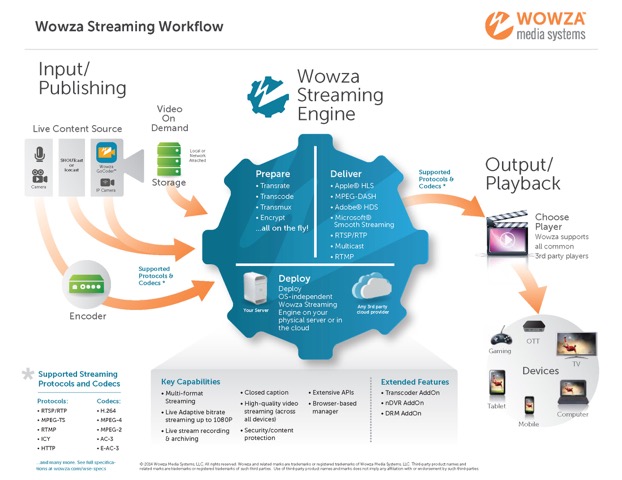With video being the communications tool of choice, if you’re dealing with bandwidth issues (read: there’s not a lot of it), it’s possible you’re one frustrated tech manager. But while streaming to low-bandwidth environments presents its own set of challenges, it’s possible. There will be compromises, there will be adjustments—and there will be the need for some technology ... and it can be done.

SonicFoundry Mediasite streaming solution
First Off: Do You Know What You Know?
Evan Davis, senior manager of solutions engineering at TRENDnet, a network solutions manufacturer based in Torrance, Calif., emphasizes that without conducting a proper site survey, tech managers will be at a loss to determine what their options are when it comes to streaming to low bandwidth areas. “See what’s available, see if there’s interference,” he urged. And based on that, calculate what’s available.
How Low Can You Go?
Zip Zieper is vice president of product management for enterprise media at Haivision, a video solutions developer headquartered in Montreal, Quebec, Canada. The company’s products—which include the Haivision Media Platform content management and delivery solution—address three main markets: broadcasting, defense, and, as Zieper’s title suggests, enterprise. He notes that each of these markets have a different definition of what low bandwidth is. “256k in the defense industry, when we’re talking about [streaming] from a platform [such as a drone] to a ground station, that’s actually a lot of bandwidth,” he said. In broadcasting, however, 256k is unacceptable. The lesson here: “What use case are you trying to accomplish? And then: what’s acceptable for that use case?” If you’re an enterprise that wants to stream talking heads, 256k could do the job.
“Know your audience,” said Rob Lipps, executive vice president of worldwide sales and marketing at Sonic Foundry, the Madison, Wisconsin-based developer behind the Mediasite Video Platform. “Know your audience, because that’s the most important thing in the decisions you’re going to make with regards to the quality of the video you’re trying to stream.” Just because streaming in HD is possible, he says, doesn’t mean you should do it—especially if you’re going to alienate a portion of your audience that doesn’t have access to the necessary bandwidth.

TRENDnet solutions
Not Live? Even Better
One way organizations get around low bandwidth issues is by pre-positioning on-demand video. Zieper likens this to filling a swimming pool with a soda straw: it may take a while, but it can be done. If your goal is to stream a 20-minute corporate announcement when people come to work at nine o’clock Monday morning, you can fill a cache with that pre-recorded content ahead of time—say on Friday afternoon. Haivision's Media Gateway, Zieper points out, acts as a cache for this purpose.
Sonic Foundry illustrates this use case through its partnership with the University of the Free State in South Africa. For the last six years, the university’s IDEAS Lab—part of its Distance Education Department—has utilized Mediasite to deliver educational content to students in 83 rural high schools in the country. The goal: to bring quality education to students who might not otherwise receive it, simply because they don’t live in urbanized regions that have access to high bandwidth.
“There are schools that don’t have internet access—they’re off the grid for the better part of the day and they use satellite to communicate with these schools,” Lipps explained. “Satellite transmission is expensive, so what we’ve engineered is a way for streaming servers to talk to each other and for someone centrally to take the videos and put them on a server in a school and the students can watch off the internet, but on a local network.”
Bit Rate Bonanza
Chances are you will have users who want to receive streams on their mobile devices—and depending where they are at the time, who knows how much bandwidth they’ll have access to. This is where technologies such as Haivision’s KB Encoder/Transcoder, a software-based solution that employs the cloud to apply Adaptive Bit Rate (ABR) distribution to individual end points. “The KB encoder can put up a cascade of available bit rates, and your client subscribes to the bit rate that’s appropriate,” Zieper explained.

Rob Lipps, Sonic Foundry
Adjust as Much—or as Little—as You Want
This year RGB Spectrum, headquartered in Alameda, Calif., released Zio, a networked AV solution that employs an H.264 codec that enables tech managers to tweak the system based on their specific needs. “You can tune the frame rate, you can tune the compression level, you can tune the resolution and the scaling; you can tune the GOP (Group of Pictures) structure—or you can have it automatically adjust,” explained Bob Ehlers, vice president of business development at RGB. Tech managers may also set their own target bit rate, which in turn will automatically adjust the frame rate and the compression level to fit the bandwidth.
Like everyone AV Technology spoke with, Ehlers notes that streaming applications require tech managers to know what they’re aiming for . . . and to be ready to make compromises based on bandwidth limitations. “You get back to the question of: what’s important to me?” he said. “Because there are many trade-offs.”
Share and Share Alike
It’s also likely that at some point, you’ll need to stream to, say, 100 people all located in the same place. If each viewer pulling a stream from the network at the same time isn’t possible, Zieper urges tech managers to consider Enterprise Content Distribution Network (ECDN) products, which act as gateways. The gateway pulls a single stream from the network, and everyone located behind that gateway can stream in either unicast or multicast, localizing the network traffic. Peer-to-peer systems, such as those offered by Hive and Kollective, also help to alleviate strain on the network during streams.
Example streaming workflow by Wowza

Be Wary of Wireless
One of the mistakes that Zieper has seen tech managers make is relying on Wi-Fi that hasn’t been optimized for live streaming. (He says this not only applies to streaming events, but also to video conferencing solutions such as Skype). “Unless the Wi-Fi networks are specifically designed for that kind of traffic, they work great in the demo and then they completely fail during live events,” he said. If you don’t have the budget to upgrade the network to improve wireless performance, one way to get around this issue is to employ set-top boxes, which act as gateways. “Just like a gateway replicates the stream to multiple end points, a set-top box multiplies the stream for a bunch of people sitting in a room,” he said. While there are wireless set-top boxes available, tech managers in this situation can also opt to connect to the wired network, alleviating some of the challenges associated with wireless networking.
Easy Does It
Finally, the best way to achieve success in any streaming venture is to work up to your ultimate goal. Need to run an all-hands event involving 40,000 viewers? It’s probably best to start with 100 set-top boxes in 10 different locations to test things out, Zieper suggests. “Start adding capacity and look at network choke points, and either add network capacity, or put in gateways, or reduce bit rates, or add multiple bit rates,” he advised. “You can have an end goal in mind—I want to reach every single employee no matter where they are in the entire world—but rare is the project that shouldn’t be phased.”
Carolyn Heinze is a regular AV Technology contributor.
Haivision
www.haivision.com
RGB Spectrum
www.rgb.com
Sonic Foundry
www.sonicfoundry.com
TRENDnet
www.trendnet.com
